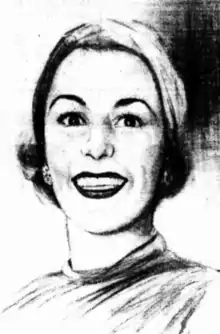Marie Collier
Marie Elizabeth Collier (16 April 1927 – 8 December 1971) was an Australian operatic soprano.[1]
Marie Collier | |
|---|---|
 Marie Collier, c.1953 | |
| Background information | |
| Birth name | Marie Elizabeth Collier |
| Born | 16 April 1927 Ballarat, Victoria, Australia |
| Died | 8 December 1971 (aged 44) London, England |
| Genres | opera |
| Occupation(s) | operatic soprano |
| Years active | 1952–1971 (her death) |
Marie Collier was born in Ballarat, Victoria to Thomas Robinson Collier (1894–1962), a railway employee, and his wife Annie Marie (née Bechaz).[1] She attended Camberwell High School from 1941 to 1943.[1][2] Due to an injured wrist, she gave up the piano and began training as a singer.[1] She first came to prominence in March 1952 singing the role of Santuzza in Cavalleria rusticana for the National Theatre Opera company in Melbourne.[1] On 10 December 1952 she married Victor Benjamin Vorwerg, a civil engineer.[1] Collier became more widely known in Australia during 1953–54 while performing Magda Sorel in Gian Carlo Menotti's The Consul,[1] for a total of seventy-five performances in Melbourne, Sydney and regional areas.
Collier studied in Milan in 1955, where she was auditioned by Lord Harewood.[1] Subsequently she was offered a contract as a regular member of the Covent Garden Opera Company. There, she made her Royal Opera House debut as the First Lady in The Magic Flute in 1956. She created the role of Hecuba in Michael Tippett's King Priam which premiered in Coventry in May 1962; and sang the leading roles in the Western premieres of Katerina Ismailova (2 December 1963)[3] at the Royal Opera House, and The Makropulos Case at Sadler's Wells (12 February 1964).[4]
Other roles at Covent Garden in subsequent seasons included Musetta in La bohème; Giulietta in The Tales of Hoffmann; Liu in Turandot; Flora in La traviata; Butterfly in Madama Butterfly; and the title role in the 1963 production of Tosca. In May 1960 her role of Musetta was described by Evan Senior as "the most astonishing and effective playing and full-voiced singing of the role I have ever heard or seen".[1]
She is probably best known as being the substitute Tosca in Covent Garden's famous 1965 revival of the 1964 Franco Zeffirelli production of the opera. When Maria Callas cancelled her appearances in three out of the four scheduled performances, Collier stepped in, to great acclaim.[5]
In 1967, she created the role of Christine Mannon in the world premiere of Marvin David Levy's Mourning Becomes Electra at the Metropolitan Opera, in which Evelyn Lear and Sherrill Milnes also sang.[6] Her other roles with the Met included Musetta, Tosca (on tour), and Santuzza in Cavalleria rusticana.[7]
In 1968, she participated in the first opera telecast in Australia (Tosca, with Donald Smith as Cavaradossi and Tito Gobbi as Scarpia).[8]
She was also noted as Chrysothemis in Sir Georg Solti's acclaimed recording of Richard Strauss's Elektra, with Birgit Nilsson in the title role.[9]
She died in London at the age of 44, in an accident in which she fell to her death from an open window.[1] She was survived by her husband, their daughter and three sons.[1] This occurred shortly after she had been chosen to sing the part of Cassandra in Berlioz's opera Les Troyens at Covent Garden.
References
- Radic, Thérèse (1993). "Biography – Marie Elizabeth Collier". Australian Dictionary of Biography. Australian National University. Retrieved 13 August 2014.
- http://www.chessmoves.com/mariecollier.htm Archived 7 January 2012 at the Wayback Machine
- The Musical Times, Vol. 104 No. 1450 (December 1963), p. 878
- The Musical Times, Vol. 105, No. 1451 (January 1964), p. 78
- "How we made: Franco Zeffirelli and John Tooley on Tosca (1964)" by Anna Timms, The Guardian, 24 July 2012
- "Restoring Luster to a Dark Melodrama" by Anthony Tommasini, The New York Times, 13 October 1998]
- http://archives.metoperafamily.org/archives
- "LISTSERV 15.5 - OPERA-L Archives". Archived from the original on 25 July 2011. Retrieved 18 December 2016.
- Strauss: Elektra
External links
- Marie Collier Collection in the Performing Arts Collection, the Arts Centre, Melbourne (magazine and newspaper clippings, photographs, programmes, scrapbooks etc.)
- "Marie Collier in Tosca, 1963 picture, at National Library of Australia
